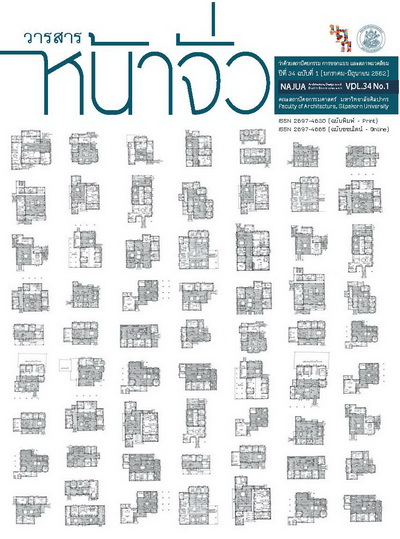การจัดการแหล่งท่องเที่ยวด้วยการประยุกต์ใช้ทฤษฎีช่วงชั้นโอกาส นันทนาการและการประเมินขีดความสามารถในการรองรับได้: กรณีศึกษาเกาะกูด
คำสำคัญ:
การวางแผนการท่องเที่ยว, การจัดการแหล่งท่องเที่ยว, ขีดความสามารถในการรองรับได้, เขตการจัดการพื้นที่, การจำแนกช่วงชั้นโอกาสทางนันทนาการ, เกาะกูดบทคัดย่อ
บทความนี้มีวัตถุประสงค์เพื่อเผยแพร่ผลงานบริการวิชาการเกี่ยวกับการจัดทำโครงการศึกษาเพื่อจัดทำโซนนิ่งและการกำหนดขีดความสามารถในการรองรับได้ (Carrying Capacity) ของการท่องเที่ยวในเขตพัฒนาการท่องเที่ยวชายทะเลภาคตะวันออก ซึ่งกระทรวงการท่องเที่ยวและกีฬาเป็นผู้สนับสนุนงบประมาณการวิจัย โครงการนี้เป็นงานบริการวิชาการ ด้วยเหตุนี้กรอบทฤษฎีและแนวความคิดในการวิจัย จึงครอบคลุมทั้งแผนและนโยบายที่เกี่ยวข้องเกี่ยวกับการท่องเที่ยวจากระดับประเทศ ระดับภูมิภาค ระดับจังหวัด และระดับท้องถิ่น กฎหมายที่เกี่ยวข้องในการใช้พื้นที่บริเวณเกาะกูด ควบคู่ไปกับการประยุกต์ใช้ทฤษฎีของขีดความสามารถในการรองรับ (Carrying Capacity) การจำแนกช่วงชั้นโอกาสด้านนันทนาการ (Recreation Opportunity Spectrum, ROS) จิตวิทยาสิ่งแวดล้อม การรับรู้ทางภูมิทัศน์ และการมีอาณาเขตครอบครองและพฤติกรรมที่เว้นว่างส่วนบุคคล เพื่อการจำแนกพื้นที่จัดทำโซนนิ่งและกำหนดขีดความสามารถในการรองรับได้ของการท่องเที่ยวในเขตพัฒนาการท่องเที่ยวของเกาะกูดที่สอดคล้องกับกิจกรรมการท่องเที่ยว สภาพทางกายภาพและความต้องการพื้นที่เชิงจิตวิทยา ตลอดจนนโยบายในการจัดการการท่องเที่ยวของพื้นที่
ในงานบริการวิชาการชิ้นนี้ได้ประยุกต์ใช้วิธีวิจัยแบบผสานวิธี ประกอบด้วย (1) การสำรวจลักษณะทางกายภาพและการใช้ประโยชน์ที่ดินของแหล่งท่องเที่ยวและพื้นที่ศึกษาบนเกาะกูดในต่างช่วงเวลา และสังเกตการณ์การใช้งานพื้นที่ว่าง พฤติกรรมของนักท่องเที่ยวและกิจกรรมการท่องเที่ยวทั้งแบบไม่มีส่วนร่วมและแบบมีส่วนร่วม (2) การใช้ระบบสารสนเทศภูมิศาสตร์ (GIS) เพื่อวิเคราะห์ข้อมูลเชิงพื้นที่ทางกายภาพเพื่อใช้ในการวิเคราะห์ความสามารถในการรองรับด้านกายภาพ เช่น ความชัน พื้นที่ธรรมชาติ การใช้ประโยชน์ที่ดิน ปริมาณอาคารและสิ่งปลูกสร้าง การใช้ประโยชน์อาคาร เป็นต้น (3) การสัมภาษณ์เชิงลึกภาคีต่างๆ ที่เกี่ยวข้อง ได้แก่ นักท่องเที่ยว เจ้าหน้าที่รัฐ องค์การปกครองส่วนท้องถิ่น ผู้ประกอบการ และประชาชนบนเกาะกูด (4) การสำรวจความคิดเห็นนักท่องเที่ยวด้วยแบบสอบถาม แล้วนำไปวิเคราะห์ทางสถิติ เพื่อใช้ในการวิเคราะห์ความสามารถในการรองรับด้านจิตวิทยา และ (5) การประชุมระดมความคิดเห็นและการประชุมขับเคลื่อนเชิงนโยบาย เพื่อหาข้อสรุปและแนวทางร่วมกันระหว่างคณะวิจัย หน่วยงานภาครัฐ ท้องถิ่น และภาคเอกชนที่เกี่ยวข้อง ในการกำหนดช่วงชั้นโอกาสทางนันทนาการ (ROS) และขีดความสามารถในการรองรับได้ด้านการท่องเที่ยว
ผลจากการวิจัยทำให้ทราบว่าช่วงชั้นโอกาสทางนันทนาการ (ROS) ที่เหมาะสมกับเกาะกูดมี 4 โซน คือ แบบสันโดษ กึ่งสันโดษไม่ใช้ยานยนต์ กึ่งสันโดษใช้ยานยนต์ และชนบท ทั้งนี้จากการวิเคราะห์ปัจจัยต่าง ๆ พบว่า เกาะกูดมีข้อจำกัดเรื่องปริมาณนํ้าใช้ต่อวัน ทำให้มีขีดความสามารถในการรองรับนักท่องเที่ยวได้ 2,280 คนต่อวัน เพราะมีจำนวนห้องพักและนํ้าใช้จำกัด ในปัจจุบันมีระดับการใช้ประโยชน์เกินร้อยละ 80 ของขีดความสามารถในด้านการรองรับได้ ส่วนในด้านกายภาพและทางจิตวิทยาสามารถรับนักท่องเที่ยวได้จำนวนมากกว่า โดยคิดเป็น 14,456 และ 9,163 คนตามลำดับ จึงมีระดับการใช้ประโยชน์น้อยกว่าร้อยละ 50 ของขีดความสามารถ ดังนั้นหากต้องการเพิ่มจำนวนนักท่องเที่ยวให้เพิ่มขึ้น ต้องปรับปรุงสิ่งอำนวยความสะดวก และแก้ไขปัญหาและพิจารณาประเด็นอื่นๆ ทางสิ่งแวดล้อม สังคมที่ส่งผลต่อความยั่งยืนของการท่องเที่ยวและคุณภาพชีวิตประชาชนเกาะกูด ได้แก่ การจัดการนํ้า การจัดการขยะ การขยายตัวของประชากรแฝง ปัญหากรรมสิทธิ์ที่ดิน การลักลอบทิ้งนํ้าเสียจากรีสอร์ท การเข้าถึงหาดส่วนตัว ระบบรถสาธารณะบนเกาะ การควบคุมปริมาณร้านอาหาร การขาดนักท่องเที่ยวช่วง Low Season และการควบคุมบริการการท่องเที่ยว
เอกสารอ้างอิง
ภาษาไทย
- Office of the National Economic and Social Development Council. (2016). Rāi ngān sarup phonkān sưksā phư̄ a pramoē n māttrathān khunnaphāp lǣng thō̜ngthı̄eo praphēt ko̜ sāmsipsām ko̜ nai sipsō̜ng čhangwat læ khō̜sanoē nǣothāng kānphatthanā [Summary report of the evaluation of quality of tourism destinations of 33 islands in 12 provinces]. BKK: Office of the National Economic and Social Development Council.
- Faculty of forestry, Kasetsart University. (2005). Rāi ngān chabap sutthāi khrōngkān sưksā khı̄t khwāmsāmāt nai kān rō̜ng rap dai khō̜ng ʻutthayān hǣng chāt khao lǣm yā - mūko̜ samet [Final report the study of carrying capacity of Khao Lam Ya-Ko Samed National Park]. BKK: Department of National Park, Wildlife and Plant Conservation.
- Emphandhu D., and Other. (2004). khūmư̄ kān čhamnǣk khēt thō̜ngthı̄eo choē ng Niwēt. [manual for classification of ecological tourism destination]. BKK: Text and Journal Publication Co.,Ltd.
- Emphandhu D. (2014). Teaching Material of 308534 Ecotourism Management. BKK: Kasetsart University.
- Wongmahadlek, P. and Other. (2017A). Rāng rāi ngān kān krāng chabap somboon khrōngkān sưksā phư̄ a čhattham sōnning læ kān kamnot khı̄t khwām sāmāt nai kān rō̜ngrap dai ō̜ng kānthō̜ngthı̄eo nai khēt phatthanākān thō̜ngthı̄eo: ko̜ samet čhangwat ra yō̜ng ko̜ chāng ko̜ kūt læ ko̜ māk čhangwat trāt. [Progress report of the study of zoning and carrying capacity for tourism management: Samed Island, Rayong Province, Chang Island, Kud Island, Mak Island, Trad Province]. BKK: Faculty of Architecture, Silpakorn University.
- Wongmahadlek, P. and Other. (2017B). Rāng rāi ngān chabap somboon khrōngkān sưksā phư̄ a čhattham sōnning læ kān kamnot khı̄t khwām sāmāt nai kān rō̜ngrap dai. ō̜ng kānthō̜ngthı̄eo nai khēt phatthanākān thō̜ngthı̄eo : ko̜ samet čhangwat ra yō̜ng ko̜ chāng ko̜ kūt læ ko̜ māk čhangwat trāt. [Final Draft of the study of zoning and carrying capacity for tourism management: Samed Island, Rayong Province, Chang Island, Kud Island, Mak Island, Trad Province]. BKK: Faculty of Architecture, Silpakorn University.
- Wongmahadlek, P. and Other. (2018). Rāi ngān chabap somboon khrōngkān sưksā phư̄ a čhattham sōnning læ kān kamnot khı̄t khwām sāmāt nai kān rō̜ngrap dai khō̜ng kānthō̜ngthı̄eo nai khēt phatthanākān thō̜ngthı̄eo: ko̜ kūt čhangwat trāt. [Final Report of the study of zoning and carrying capacity for tourism management: Samed Island, Rayong Province, Chang Island, Kud Island, Mak Island, Trad Province]. BKK: Faculty of Architecture, Silpakorn University.
- Satitvipawee P., and other. (2013). Khrōngkān sưksā kānphatthanā sakkayaphāp dān kānčhatkān phư̄ nthı̄ læ sapphayākō̜n phư̄ a kān songsoē m kānthō̜ngthı̄eo yāng yangyư̄ n. [The Study of Capacity Building Development on Land Use and Tourism Resource Management for Sustainable Tourism Promotion]. BKK: The Secretariat of the Senate.
- Tongaroon N. (2010). “Khwāmsamphan rawāng sathāpattayakam phūm that læ phư̄nthı̄ wāng : khunnaphāp khō̜ng kān prap plı̄an thı̄ wāng kitčhakam læ bō̜ribot. [The Relationship between Architecture, Landscape, and Open Space: Qualities of Spatial Transformation, Activities, and Context]”. in Academic Journal of Architecture, 59: 105-118.
- Rachno R., (2004). Kān prayuk rabop sārasonthēt phūmisāt čhamnǣk chūang chan ʻōkāt dān kānthō̜ngthı̄eo choē ng Niwēt nai khrōngkhāi kānthō̜ngthı̄eo phư̄ nthı̄ lumnam mǣ khān čhangwat Chı̄ang Mai. Master Degree Thesis, BKK: Kasetsart University.
- Horayangura V. (2006). Kān prayuk rabop sārasonthēt phūmisāt čhamnǣk chūang chan ʻōkāt dān kānthō̜ngthı̄eo choē ng Niwēt nai khrōngkhāi kānthō̜ng thı̄eo phrưttikam manut kap saphāpwǣtlō̜m: mūnlathān thāng phrưttikam phư̄ a kānʻō̜kbǣp læ wāngphǣn. [Human behavior and environment]. BKK: Chulalongkorn Press.
ภาษาต่างประเทศ
- Belle, N. & Bramwell, B. (2005). “Climate Change and Small Island Tourism: Policy Maker and Industry Perspectives in Barbados”. in Journal of Travel Research, 44(1): 32 - 41.
- Coccossis, H. & Mexa, A. (2004). The challenge of tourist carrying capacity assessment: theory and practice. NewYork: Ashgate Publishing.
- Clark, R.N. & Stankey, G.H. (1979). The Recreation Opportunity Spectrum: A Framework for Planning, Management, and Research. U.S. Department of Agriculture, Forest Service.
- Floyd, M. & Gramman, J. H. (1997). “Experience based setting management: Implications for market segmentation of hunters”. in Leisure Sciences, 19(2): 113-128.
- Manfredo, M. (1983). “A test of concepts inherent in experience-based setting management for outdoor recreation areas”. in Journal of Leisure Research. 15: 263 - 283.
- Martin, B.S & Uysal, M. (1990). “An examination of the relationship between carrying capacity and tourist life-cycle; Management and policy implication”. in Journal of Environment Management, 31: 327-333.
- Payne, R.J., A. Carr & E. Cline. (1997). Applying the Recreation Opportunity Spectrum (ROS) in Two Canada National Parks. Occasional Paper8. Ottawa, ON: Natural Resources Branch, National Parks, National Parks, Parks Canada.
- Pretty, J. & Ward, H. (2001). “Social capital and the environment”. in World Development, 29(2): 209 - 227.
- Shelby, Bo & Heberlein, Thomas A. (1986). Carrying capacity in recreation settings. Oregon: Oregon State University Press.
- United State Department of Agriculture Forest Service (USDA). (1990). ROS Primer and Field Guide, R6-REC-021-90. United States Department of Agriculture.
- Wagar, J.A. (1964). The Carrying Capacity of Wild Lands for Recreation. Washington D.C.: Publication of Society of American Forester.





